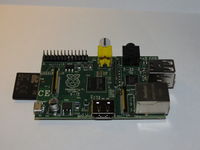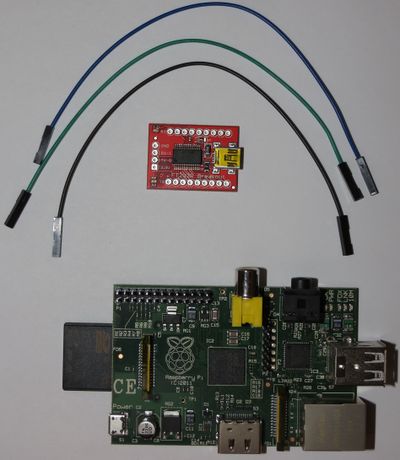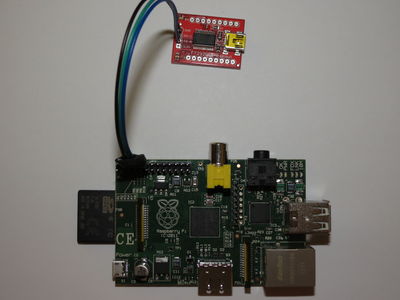Difference between revisions of "Raspberry Pi"
(→Serial Port: Added details about my serial port setup) |
|||
| Line 63: | Line 63: | ||
The bootcode.bin, loader.bin, and start.elf files are all opaque to ARM programmers because they are GPU code files meaning we cannot change them. For Linux the <tt>kernel.img</tt> file is loaded starting at 0x00000000, which puts the start of Linux code (head.S) at 0x00008000<ref name="rpilinux" />. This file is built by the <tt>mkimage</tt><ref name="mkimage" /> tool associated with the Raspberry Pi distribution. It *should not* be needed for non-Linux code because it only attaches some special code that is used for Linux kernel parameter passing so the kernel doesn't need extra modifications<ref name="linux32k" />. As an example: [http://cgit.haiku-os.org/haiku/tree/src/system/boot/platform/raspberrypi_arm/entry.S HaikuOS] does not use the <tt>mkimage</tt> tool to get their kernel to boot. | The bootcode.bin, loader.bin, and start.elf files are all opaque to ARM programmers because they are GPU code files meaning we cannot change them. For Linux the <tt>kernel.img</tt> file is loaded starting at 0x00000000, which puts the start of Linux code (head.S) at 0x00008000<ref name="rpilinux" />. This file is built by the <tt>mkimage</tt><ref name="mkimage" /> tool associated with the Raspberry Pi distribution. It *should not* be needed for non-Linux code because it only attaches some special code that is used for Linux kernel parameter passing so the kernel doesn't need extra modifications<ref name="linux32k" />. As an example: [http://cgit.haiku-os.org/haiku/tree/src/system/boot/platform/raspberrypi_arm/entry.S HaikuOS] does not use the <tt>mkimage</tt> tool to get their kernel to boot. | ||
| − | As mentioned above, to get a network boot working we should be able to make a new kernel.img file that enables serial port access and network access then copies and jumps to a known offset for execution. As a starting point [https://github.com/dwelch67/raspberrypi dwelch67] has something like this on github (though it seems to be very specific and not network oriented). | + | As mentioned above, to get a network boot working we should be able to make a new kernel.img file that enables serial port access and network access then copies and jumps to a known offset for execution. <strike>As a starting point [https://github.com/dwelch67/raspberrypi dwelch67] has something like this on github (though it seems to be very specific and not network oriented).</strike> It seems that [https://github.com/gonzoua/u-boot-pi/tree/rpi gonzoua] has added preliminary Raspberry Pi support for Das U-Boot, I have confirmed that it compiles and executes using my cross-compiler, moreover is can get an IP address and ping hosts. It should also be able to TFTP boot a kernel, but I haven't been able to confirm that yet (as my network configuration is a bit weird). |
| + | |||
| + | To compile Das U-Boot, I ran two commands: | ||
| + | |||
| + | <source lang="bash"> | ||
| + | $ make ARCH=arm CROSS_COMPILER=<cross-compiler location> raspberry_pi_config | ||
| + | $ make ARCH=arm CROSS_COMPILER=<cross-compiler location> | ||
| + | </source> | ||
| + | |||
| + | Then copy the u-boot.bin file to the SD card as kernel.img, reboot and you should have serial access to U-Boot. Type `usb start` to bring up the USB subsystem (which includes the Ethernet adapter) and `dhcp` will acquire an IP address/tftp server (it might also attempt to download a boot image). | ||
= Command Line Information = | = Command Line Information = | ||
Revision as of 18:38, 17 June 2012
The Raspberry Pi (RPi) does exist, but while waiting for it to be delivered here are some notes to make it easier to begin porting Xinu to the platform. (Work in Progress)
Contents
Hardware
You will need the device itself. As of mid-March 2012, this can be ordered for ~$40 from Newark/element14 or RS Components and only includes the board itself (no power supply, cables, or case).
Power Supply
The RPi uses a fairly standard USB micro-B connector for power (only the power pins are physically present). It needs 700 mA at 5 V, so most computers or cell phone chargers should work. Embedded Linux source
Serial Port
The shipped RPi board doesn't come with a serial port attached (no surprise there). But it does have an expansion header that includes pin outs for a serial port (and more). The details can be found on the Embedded Linux RPi page. You will probably just want to solder on the full 2x13 pin header then deal with the outputs later incase you want to take advantage of the other pins. Turns out the board has the 2x13 header already soldered on (I guess it didn't add too much to the cost of production).
The computer I used does not have a serial port on it, so I ended up getting a serial to USB converter from Sparkfun, along with some jumper wires.
Once the serial transceiver board is wired up to the Raspberry Pi, connect a host system and use a terminal emulator (I used the Xinu console tools `tty-connect`) with a baud rate of 115,200, 8 data bits, no parity, 1 stop bit. During the Raspberry Pi boot (of a Fedora kernel at least), you will be able to see kernel log messages emitted to the serial console. There isn't anything too exciting in the boot messages, but on my install the first few lines look like:
[ 0.000000] Initializing cgroup subsys cpuset
[ 0.000000] Initializing cgroup subsys cpu
[ 0.000000] Linux version 3.1.9 (mockbuild@cdot-panda-5-4) (gcc version 4.5.1 20101112 (Red Hat 4.5.1-5) (GCC) ) #1 PREEMPT Sat Mar 3 21:58:00 UTC 2012
[ 0.000000] CPU: ARMv6-compatible processor [410fb767] revision 7 (ARMv7), cr=00c5387d
[ 0.000000] CPU: VIPT nonaliasing data cache, VIPT nonaliasing instruction cache
[ 0.000000] Machine: BCM2708
[ 0.000000] Memory policy: ECC disabled, Data cache writeback
[ 0.000000] Built 1 zonelists in Zone order, mobility grouping on. Total pages: 48768
[ 0.000000] Kernel command line: dma.dmachans=0x3c bcm2708_fb.fbwidth=720 bcm2708_fb.fbheight=480 bcm2708.boardrev=0x0
bcm2708.serial=0x14be9109 smsc95xx.macaddr=B8:27:EB:BE:91:09 dwc_otg.lpm_enable=0 console=ttyAMA0,115200 kgdboc=ttyAMA0,115200
console=tty1 root=/dev/mmcblk0p2 rootfstype=ext4 rootwaitSD Card
You will want at least a Class 6 or above SD card (lower class cards have been known to have read failures). I (Michael) ordered two Kingston 8 GB Class 4 SDHC memory cards from Amazon. 8 GB is probably excessive, but they only cost ~$7 each, and if you intend to have a full Linux install available it might not be a bad idea to go for > 4 GB.
Software
Xinu is, of course, the target operating system for the RPi platform. However, there are some steps to take before we get there.
Booting
Sadly the RPi does not come with a standard bootloader. Instead it simply boots off the SD card (and only the SD card) when power is applied, so a straight from the network boot is not an option. However, SD cards are low cost so you should be able to install a bootloader on the SD card that enables a network boot. It may "taint" the environment, but it shouldn't be horrible or worse than a typical boot loader.
It looks like the grub bootloader should be able to support network booting Grub PXE network boot. This is probably the most viable option, but other options may exist and work better for the RPi.
The boot process seems to be as follows[1]:
- Power applied to the Raspberry Pi
- Graphic Processor Unit (GPU) begins executing a stage 1 bootloader found in ROM on the chip
- The stage 1 bootloader reads the SD card and loads stage 2 (/boot/bootcode.bin) into on-chip cache (L2)
- GPU executes stage 2 bootloader which enables SDRAM and reads a stage 3 bootloader (/boot/loader.bin) into SDRAM
- GPU executes stage 3 bootloader which understands how to read ELF files and reads the GPU firmware bootloader (/boot/start.elf)
- /boot/start.elf reads /boot/config.txt, /boot/cmdline.txt, and /boot/kernel.img
- /boot/kernel.img is essentially the Linux zImage (i.e. ARM code), it contains some parameters in the first 32k but the rest is zImage proper
The bootcode.bin, loader.bin, and start.elf files are all opaque to ARM programmers because they are GPU code files meaning we cannot change them. For Linux the kernel.img file is loaded starting at 0x00000000, which puts the start of Linux code (head.S) at 0x00008000[2]. This file is built by the mkimage[3] tool associated with the Raspberry Pi distribution. It *should not* be needed for non-Linux code because it only attaches some special code that is used for Linux kernel parameter passing so the kernel doesn't need extra modifications[4]. As an example: HaikuOS does not use the mkimage tool to get their kernel to boot.
As mentioned above, to get a network boot working we should be able to make a new kernel.img file that enables serial port access and network access then copies and jumps to a known offset for execution. As a starting point dwelch67 has something like this on github (though it seems to be very specific and not network oriented). It seems that gonzoua has added preliminary Raspberry Pi support for Das U-Boot, I have confirmed that it compiles and executes using my cross-compiler, moreover is can get an IP address and ping hosts. It should also be able to TFTP boot a kernel, but I haven't been able to confirm that yet (as my network configuration is a bit weird).
To compile Das U-Boot, I ran two commands:
$ make ARCH=arm CROSS_COMPILER=<cross-compiler location> raspberry_pi_config
$ make ARCH=arm CROSS_COMPILER=<cross-compiler location>Then copy the u-boot.bin file to the SD card as kernel.img, reboot and you should have serial access to U-Boot. Type `usb start` to bring up the USB subsystem (which includes the Ethernet adapter) and `dhcp` will acquire an IP address/tftp server (it might also attempt to download a boot image).
Command Line Information
cat /proc/cpuinfo
Processor : ARMv6-compatible processor rev 7 (v6l)
BogoMIPS : 697.95
Features : swp half thumb fastmult vfp edsp java tls
CPU implementer : 0x41
CPU architecture: 7
CPU variant : 0x0
CPU part : 0xb76
CPU revision : 7
Hardware : BCM2708
Revision : 0000
Serial : 0000000014xxxxxxcat /proc/meminfo
MemTotal: 186540 kB
MemFree: 130592 kB
Buffers: 9552 kB
Cached: 29360 kB
SwapCached: 0 kB
Active: 18404 kB
Inactive: 29176 kB
Active(anon): 9108 kB
Inactive(anon): 4 kB
Active(file): 9296 kB
Inactive(file): 29172 kB
Unevictable: 0 kB
Mlocked: 0 kB
HighTotal: 0 kB
HighFree: 0 kB
LowTotal: 186540 kB
LowFree: 130592 kB
SwapTotal: 0 kB
SwapFree: 0 kB
Dirty: 24 kB
Writeback: 0 kB
AnonPages: 8680 kB
Mapped: 10476 kB
Shmem: 448 kB
Slab: 5648 kB
SReclaimable: 2816 kB
SUnreclaim: 2832 kB
KernelStack: 568 kB
PageTables: 688 kB
NFS_Unstable: 0 kB
Bounce: 0 kB
WritebackTmp: 0 kB
CommitLimit: 93268 kB
Committed_AS: 94416 kB
VmallocTotal: 188416 kB
VmallocUsed: 896 kB
VmallocChunk: 186708 kBPlatform
- BCM2835 SoC
- Contains ARM 1176JZF-S processor (technical reference manual; implements ARMv6 instruction set, you'll need to register with ARM for the PDF.)
- File:BCM2835-Peripherals.pdf should cover making the serial port work
- SMSC LAN9512 USB Hub and 10/100 Ethernet


